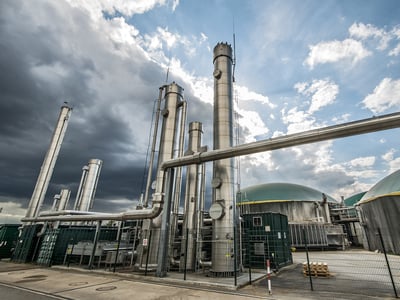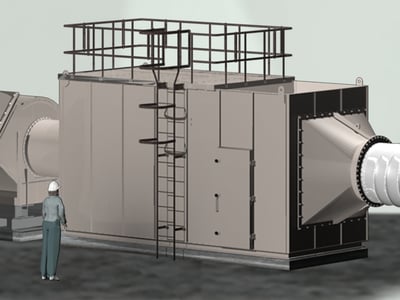Quando o lixo orgânico biodegradável é coletado ou segregado de um fluxo misto de lixo, ele fornece valor como combustível para a produção de energia ou como matéria-prima para composto ou fertilizante. Importantes categorias de resíduos orgânicos incluem esterco, resíduos de alimentos, aparas de grama e resíduos de colheitas.
Os processos de digestão anaeróbica (sem oxigênio) são usados para fazer biogás, enquanto o composto é feito usando um processo de digestão aeróbia (com oxigênio). Qualquer processo de biodegradação produz uma mistura complexa de gases que pode criar um odor desagradável ou, no caso do biogás, um perigo de corrosão para o motor de combustão. A filtragem molecular ajuda a eliminar esses problemas.
O tratamento de resíduos - e do ar - é crucial em usinas de biogás
O biogás está ganhando importância em todo o mundo à medida que resíduos orgânicos reciclados substituem fontes de combustíveis fósseis não sustentáveis para a produção de energia. Quando o lixo orgânico é digerido em um processo anaeróbico, o metano resultante - o combustível para a produção de energia - pode ser fortemente contaminado com substâncias indesejáveis que podem causar corrosão ou abrasão.
O biogás pode conter estas substâncias prejudiciais:
- Sulfeto de hidrogênio (H2S)
- Amônia (NH3)
- Siloxanos
- Hidrocarbonetos aromáticos
- Halogênios (cloro, flúor)
- Particulas
Se altas concentrações de H2S atingirem o motor a gás onde o metano é queimado para gerar energia, o motor pode sofrer corrosão interna devido à combinação do gás ácido e altas temperaturas. A corrosão do motor requer tempo de inatividade não programado para manutenção e reparo - aumentando os custos de manutenção e reduzindo a produção e o lucro da planta de biogás. Muitos digestores anaeróbicos e motores de biogás estão localizados próximos à matéria-prima de resíduos orgânicos, ou seja, em fazendas. A filtração molecular em linha é o método aceito para remover o sulfeto de hidrogênio do biogás antes da combustão.
Controle os odores da compostagem com filtragem molecular
Resíduos orgânicos podem ser parcialmente biodegradados em um processo aeróbio para fazer composto ou produtos que melhoram o solo. Pouco ou nenhum sulfeto de hidrogênio é produzido, mas muito do conteúdo orgânico volátil dos resíduos é liberado. Isso pode criar um incômodo de odor devido à intensidade muito alta. A mistura de gases responsável pelo odor é muito complexa, mas um constituinte principal serão os terpenos, como o alfa-pineno.
Você pode usar a filtragem molecular como um método de controle de odores na exaustão do prédio de produção e no sistema de ventilação das máquinas usadas dentro da sala de processamento para virar e misturar os resíduos em decomposição.
Com as soluções de filtragem molecular dedicadas da Camfil, você pode manter os odores problemáticos longe das áreas vizinhas e filtrar os gases contaminados antes que cheguem ao motor de combustão.
Brasil

